17. Machine design¶
This weeek I started working on the Fab Academy again after 2 months of volunteering work with my FabLab. I have been managing the creation of face shields for local hospitals and I also set up Makers Sicilia, a network on makers in my region who were working on solutions to the COVID-19 emergency. I have also joined the group Make in Italy, which is an Italian association of makers, and helped to identify projects that could be easily replicated all over in Italy. These months have been super intense and I have learnt a lot about the power of FabLabs and especially the power of collaboration among makers. While in Italy there are still a few hundreds cases of COVID-19 each day, the situation is slowly going back to normal and at the end of this week I will be able to access the FabLab again. Oh… in the meantime I am in Sicily! So I will continue the Fab Academy in the lab I created here in Marsala.
Tasks¶
We had a discussion on projects that we could bring forward together remotely and we finally ended up choosing to work on a planetarium. This is part of my final project but I figured it would have been too hard for me alone to develop the gears’ system, so I think that working on this project all together will help me to advance with my project and add new features.
We shared tasks so that Zina is in charge of the GUI for control system, Spencer is in charge motor controllers and frame, Madison supports the 3D modeling of the gears and I am in charge of researching the gears system and to do some research on existing projects. The gears part has been quite complicated for me since I decided to work on this project as my final project. But I think that with the help of the others we will be able to come up with a great system!
Research¶
My contribution to the group has been first of all to screen available projects online. I found a bunch of useful links and two projects were especiallhy interesting:
This project is simply amazing! This student created from scratch an entire planetarium with over 70 gears. He used a do-it-yourself CNC, fusion 360 and the program gearotic motion to come up with the gears combination.
This project provides valuable information on how to think the mechanical part of the planetarium, and we will work on simplifying the mechanical part by using stepper motors or DC motors. I think that by using 3/4 motors we can reduce the number of gears to less than 20. But still need to work on it…
This project is the final project of a student of the Fab Academy in 2018 and it’s an orrery that can be used as a night lamp controlled by a phone.

Here there is a video presenting this project.
Other useful projects that I reviewed are these:
- Make a Tellurion (sun-earth-moon Orrery) for Your Kid
- https://www.instructables.com/id/Solar-System-Orrery-3D-Printed/
Gears¶
Studying gears is faschinating. The first important concept about gears is the gear ratio. Definition: a gear ratio is a direct measure of the ratio of the rotational speeds of two or more interlocking gears. As a general rule, when dealing with two gears, if the drive gear (the one directly receiving rotational force from the engine, motor, etc.) is bigger than the driven gear, the latter will turn more quickly, and vice versa. We can express this basic concept with the formula Gear ratio = T2/T1, where T1 is the number of teeth on the first gear and T2 is the number of teeth on the second. Therefore, the gear ration shows how many times a gear has to turn for the other one to make an entire turn. A ratio of 1:3 means that a gear of 1 teeth will turn 3 times for each turn of the gear of 3 teeth. So, if we want to create gears for a clock, for example, we need to have a ratio of 1:12 because you need the gears with the minutes to turn 12 times for the gears with the hours to go back to the original position. Now, gears with one tooth are of course not possible and this tutorial suggests to have gears with at least with 7 teeth. So, in the case of the watch, we would have 7:84.

Now there is a problem. A gear of 84 teeth would be pretty big! To avoid making such a big gear, it is possible to use 3 or gears instead of 2 as long as the ratio stays the same.
IMPORTANT: The important thing to remember when dealing with gear trains with more than two gears is that only the driver and driven gears (usually the first and last ones) matter. In other words, the idler gears don’t affect the gear ratio of the overall train at all. But if we had the third gear, the gear would change rotation.

|

|
I had to figure out how to calculate compound gear ratios.. I followed this tutorial. When a gear train has multiple stages, the gear ratio for the overall gearing system is the product of the individual stages. For example, for the gear at left the blue gears are 7 and 21 teeth, while the green gears are 9 and 30 teeth. Thus, the first gear ratio is 7:21 and the second is 9:30. Multiplying the two together gives (7x9):(21x30) = 63 : 630, which is 1:10. So the big green gear will make 1 turn for every 10 turns of the small blue gear.
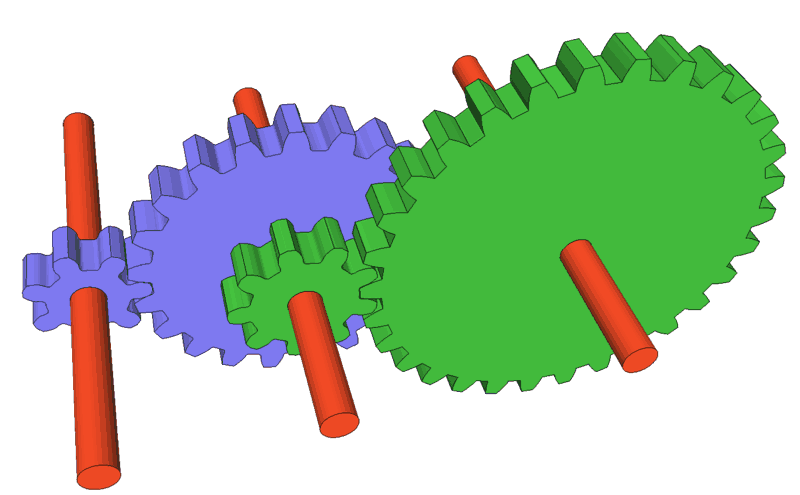
Another important concept for our project is the speed of the gears. We need to identify the final speed of the gear driving the planet by setting the speed of the gear connected to the motor. In case of 2 gears, the calculation is pretty simple. It is enough to use this formula: S1 × T1 = S2 × T2. So, if for example we know that a small gear connected to the motor has a speed of 130 rpm (rotations per minutes) and we know that this gear has 7 teeth and the gear driving the planet has 30 teeth, then the speed of the larger gear would be 130rpm*7:30 = 30.33rpm.
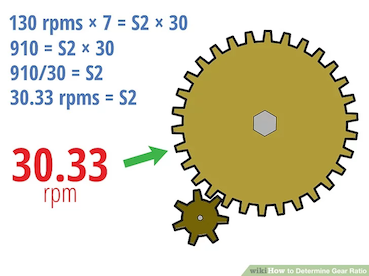
Which gears system should we use for this project?¶
We discussed with the team what system would work best. We have several options.
OPTION 1¶
We could use a complex system of gears like the one used in the mechanical planetarium with over 70 gears. The most useful tool to create gears would have been the software gearotic motion. If I understood well from the tutorial, with this program you can set the ratio you need and suggests a gears system that would work with that ratio. Unfortunately, this program does not work for mac. So I looked for alternatives, but I could not find any option that allows you to enter the ratio and provides suggested gears system. I only found this alternative algorithm developed in R for a similar project:
i0 = 32
i1 = 32
i2 = 32
i3 = 32
d = 100</p><p>for (x1 in 15:24) {
for (x2 in 15:24) {
for (x3 in 15:22) {
for (y3 in 15:22) {
for (y2 in 15:24) {
for (y1 in 15:24) {
for (y0 in 16:21) {
ratio <- (x1 /(i1 -x1)) * (x2 /(i2 -x2)) * (x3 /(i3 -x3)) *
(y3 /(i3 - y3)) * (y2 /(i2 - y2)) *(y1 /(i1 - y1)) *(y0 /(i0 - y0))
if (abs(ratio-365.25) < d) {
print(abs(ratio-365.25))
d <- abs(ratio-365.25)
if (d <5) {
print(paste(x1,x2,x3,y3,y2,y1,y0))
print((y3 /(i3 - y3)) * (y2 /(i2 - y2)) *(y1 /(i1 - y1)) *(y0 /(i0 - y0)))
print("")
}
}
}
}
}
}
}
}
}
However, I can’t use R and it’s too time-consuming in this week to try to figure out how to use this program. More generally, the gears systems developed in this way are very VERY complex for me.
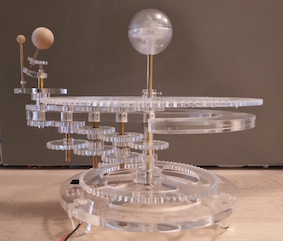
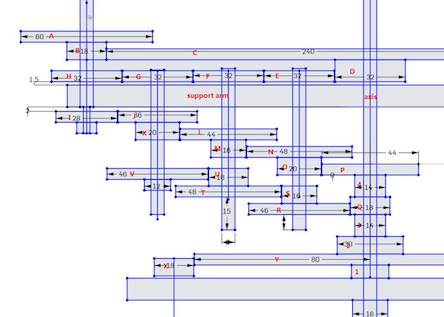
Anyway, I decided to do some tests by picking the gears ratio that were used in the mechanical planetarium project. These are:
- Mercury: 10, 50, 50 / 59, 21, 71
- Venus: 11, 92, 29 / 63, 53, 79
- Earth: 11, 31, 31 / 79, 23, 85
- Mars: 12, 74, 19 / 73, 73, 87
- Jupiter: 28, 71 / 92, 39
- Saturn: 35, 61 / 92, 39
- Uranus: 18, 47 / 92, 83
- Neptune: 16, 31 / 89, 86
This of course is not the only combination available, but for now I wanted to start testing some programs to make gears. I tested 2 programs: gears generator online and spur gears in fusion 360.
GEARS GENERATOR¶
THe first option I tested to create the gears is the online gears generator. I watched this tutorial to understand how it works. And I also created the gears for Mercury as a test based on the gears provided in the mechanical planetarium project: Mercury: 10, 50, 50 / 59, 21, 71. This gear combination is obtained by inputting to the program the time in which the gear connected to the motor (or anyway to the manual control) makes one turn (which the student in the project set at 25 days) and the time in which the planet makes one round around the sun (which in the case of Mercury is 87.969 days.
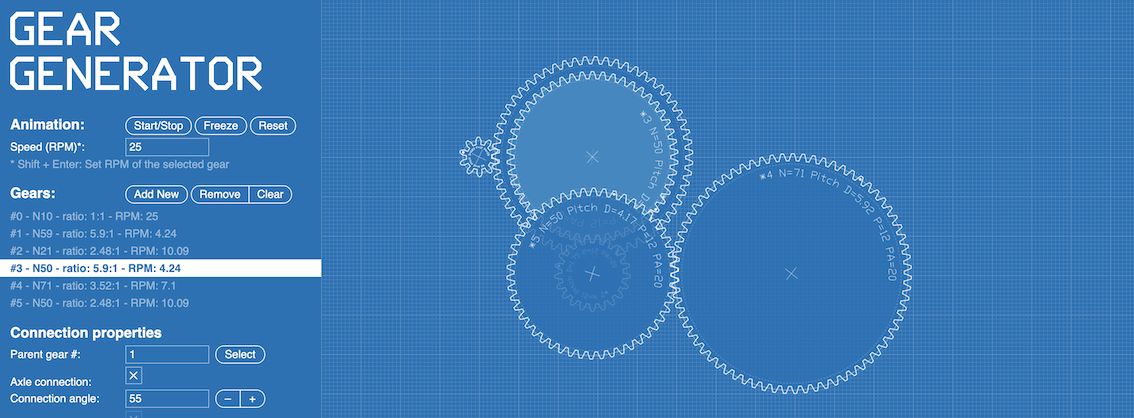
The result shows a correct ratio for the final gear which rotates the planet which has 71 teeth. In fact, considering that the initial gear makes a round each 25 days, we would have that the 71 teeth gears makes one round each: 25 days / 10 * 59 / 50 * 21 / 50 * 71 = 87.969 days.
FUSION 360¶
Tutorials on spur gears: https://www.youtube.com/watch?v=ZakT54JIhB8&t=2s https://www.youtube.com/watch?v=KbhSQZ236EE&t=81s
OPTION 2¶
Alternatively, we could use a simpler system with motors for each planet. That would save us quite a lot of headaches to figure our the gears system. In this case, we would need 2 gears for each planet. One connected to the motor and one connected to the ring of each planet. Something like this system used for a clock:

In this case, we would only need to set the speed of the motor so that the planets rotate at the correct relative speed with each other. These are the original rotations speed of 8 planets: following rotation speeds for the 8 planets:
- Mercury: 87.969 days
- Venus: 224.701 days
- Earth: 365.256363004 days
- Mars: 686.971 days
- Jupiter: 4331.59 days
- Saturn: 10759.22 days
- Uranus: 30688.5 days
- Neptune: 60182 days
So, we need to identify the speed for each of the motors so that the relative speed is correct. To to this I would need to understand better how the stepper motor works.